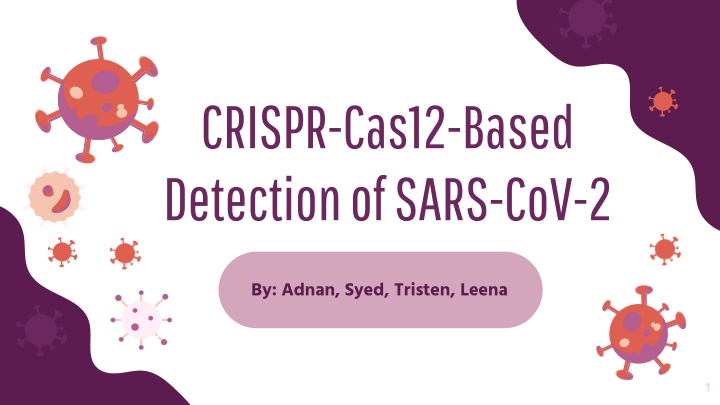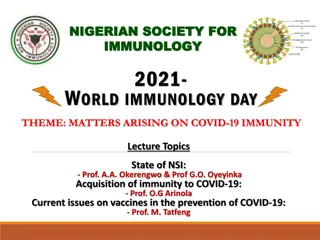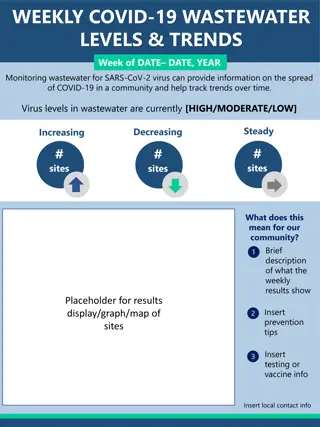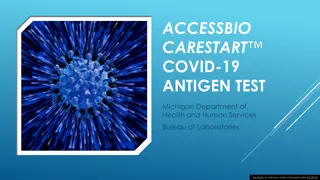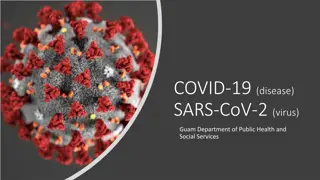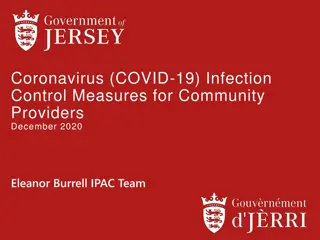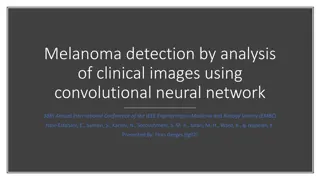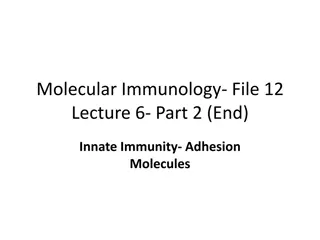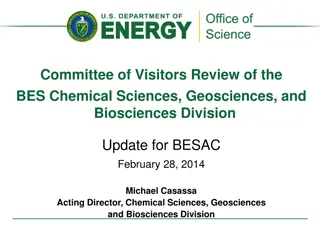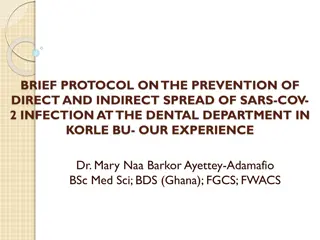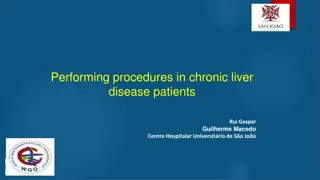CRISPR-Cas12-Based Detection of SARS-CoV-2 Overview
This discusses the development of CRISPR-Cas12 technology for rapid and accurate detection of SARS-CoV-2, highlighting advantages over traditional diagnostics and showcasing timelines and leading authors.
Download Presentation

Please find below an Image/Link to download the presentation.
The content on the website is provided AS IS for your information and personal use only. It may not be sold, licensed, or shared on other websites without obtaining consent from the author.If you encounter any issues during the download, it is possible that the publisher has removed the file from their server.
You are allowed to download the files provided on this website for personal or commercial use, subject to the condition that they are used lawfully. All files are the property of their respective owners.
The content on the website is provided AS IS for your information and personal use only. It may not be sold, licensed, or shared on other websites without obtaining consent from the author.
E N D
Presentation Transcript
CRISPR-Cas12-Based Detection of SARS-CoV-2 By: Adnan, Syed, Tristen, Leena 1
Introduction Introduction Issue Lack of access to rapid and accurate diagnostics 02 02 Last 40 Years Many large-scale epidemics 01 01 SARS-CoV-2 Increased need for diagnostics 03 03 2 2 (Broughton et al., 2020)
Limitations of Previous Diagnostics Limitations of Previous Diagnostics 4-6 hours to detect virus Expensive equipment Training required qRT-PCR Time needed for detectable immune response Serological Tests 3 3 (Broughton et al., 2020) (CDC., 2020)
DETECTR Advantages Over Current Diagnostics DETECTR Advantages Over Current Diagnostics Detection takes 30-40 min Comparable accuracy to qRT-PCR Isothermal signal amplification Single nucleotide target specificity Use of lateral flow strips for easy readouts (Point of Care Testing) DETECTR 4 (Broughton et al., 2020)
Use of CRISPR/Cas Technology in Diagnostics Use of CRISPR/Cas Technology in Diagnostics Guide RNA Cas Protein Target DNA 5 Figure created in BioRender.com (Srivastava et al., 2020)
Timeline of Assays Using CRISPR/Cas Technology Timeline of Assays Using CRISPR/Cas Technology SHERLOCK 2016 2016 2018 2018 Cas13: Zika and Dengue Virus (Gootenberg et al., 2017) NASBACC Cas9: Zika Virus (Pardee et al., 2016) HOLMES ASSAY Cas12 (Li et al., 2018) 2017 2017 6
Timeline of Assays Using CRISPR/Cas Technology Timeline of Assays Using CRISPR/Cas Technology DETECTR SHERLOCK v2 Multiplexing Cas13 and Cas12 March 2020 March 2020 Cas12 (Broughton et al., 2020) (Gootenberg et al., 2018) AIOD CRISPR Cas12 (Ding et al., 2020) 2018 2018 April 2020 April 2020 7
Lead Authors Lead Authors Xianding Deng Doctor of Philosophy 24 publications Research interests: Next generation sequencing James P Broughton Senior Manager Mammoth Biosciences 12 publications POC using CRISPR Technology 8 (ResearchGate, n.d.) (Mammoth Biosciences, Inc., 2021) (Broughton et al., 2020)
DETECTR DETECTR - -How does it work? How does it work? 9 Figure created in BioRender.com
DETECTR DETECTR - -How does it work? How does it work? 10 (Broughton et al., 2020)
DETECTR Design DETECTR Design Cas12 guide RNA (gRNA) specificity. The nucleoprotein gene (N) gRNA is specific for SARS-CoV-2, whereas the envelope gene (E) gRNA is able to detect three SARS-like coronavirus strains. gRNAs specifically target SARS- CoV-2 or broadly detect related coronavirus strains. 11 (Broughton et al., 2020)
12 (Broughton et al., 2020)
DETECTR Visualization DETECTR Visualization 13 (Broughton et al., 2020)
DETECTR Visualization DETECTR Visualization 14 (Broughton et al., 2020)
DETECTR Limit of Detection DETECTR Limit of Detection 15 (Broughton et al., 2020)
DETECTR Cross Reactivity DETECTR Cross Reactivity No Cross Reactivity when tested experimentally 95% positive predictive agreement 100% negative predictive agreement 16 (Broughton et al., 2020)
Summary of Paper Summary of Paper Uses RT LAMP followed by CRISPR Cas12-based detection to distinguish SARS-CoV-2 specifically Can run in approximately 30 40min Easily visualized on a lateral flow strip Higher limit of detection No Cross Reactivity 17 (Broughton et al., 2020)
Limitations Limitations Lack of PAM sequence for N1 and N3 gene Use of only one Cas protein (further multiplexing capability) Limited reagent availability Higher Limit of Detection (Clinical presence) Less sensitive compared to RT-PCR (Srivastava et al., 2020) (Cebrian-Serrano et al., 2017) (Serrano, et al. 2020) (MammothBioscience, 2019) 18 (University of Oxford Medical Sciences Division, n.d.)
Further Research Questions: Merging Testing Strips Further Research Questions: Merging Testing Strips Fewer reagents used More cost effective Lateral flow testing strips required for testing of each gene Lateral flow testing strip for antibody detection 19 (JOYSBIO Biotechnology et al., 2020)
Further Research Questions: PAM Sequences Further Research Questions: PAM Sequences Amplification region Increase accuracy of test Conserved Regions Multiplexing 20 20 (MammothBioscience, 2019)
Further Research Questions: Other Cas Proteins Further Research Questions: Other Cas Proteins PAM Sequence Single or Double Stranded DNA DNA or RNA Workflow of using different Cas proteins, depending on their preferred nucleic acid substrate and potential read out methods 21 (MammothBioscience, 2019) (Wang et al., 2020)
Different CRISPR assay protocols using different equipment, reagents and readout methods. 22 (Wang et al., 2020)
Further Implications: Beyond COVID Further Implications: Beyond COVID- -19 19 Other zoonotic viruses Bacterial diagnosis Cancer (Vangah et al., 2020) (Huang et al., 2018) 23
THANKS For Listening CREDITS: This presentation template was created by Slidesgo Slidesgo, including icons by Flaticon, and infographics & images by Freepik Flaticon Freepik 24
References References Broughton, J. P., Deng, X., Yu, G., Fasching, C. L., Servellita, V., Singh, J., Miao, X., Streithorst, J. A., Granados, A., Sotomayor-Gonzalez, A., Zorn, K., Gopez, A., Hsu, E., Gu, W., Miller, S., Pan, C., Guevara, H., Wadford, D. A., Chen, J. S., & Chiu, C. Y. (2020). CRISPR-Cas12-based detection of SARS-CoV-2. Nature Biotechnology, 38(7), 870-874. Centers for Disease Control and Prevention. (2020, January 24). Real-time RT PCR Panel for Detection 2019-nCoV. https://stacks.cdc.gov/view/cdc/84526 Ding, X., Yin, K., Li, Z., & Liu, C. (2020). All-in-One Dual CRISPR-Cas12a (AIOD-CRISPR) Assay: A Case for Rapid, Ultrasensitive and Visual Detection of Novel Coronavirus SARS-CoV-2 and HIV virus. bioRxiv : the preprint server for biology, 2020.03.19.998724. Gootenberg, J. S., Abudayyeh, O. O., Kellner, M. J., Joung, J., Collins, J. J., & Zhang, F. (2018). Multiplexed and portable nucleic acid detection platform with Cas13, Cas12a, and Csm6. Science, 360(6387), 439 444. Gootenberg, J. S., Abudayyeh, O. O., Lee, J. W., Essletzbichler, P., Dy, A. J., Joung, J., Verdine, V., Donghia, N., Daringer, N. M., Freije, C. A., Myhrvold, C., Bhattacharyya, R. P., Livny, J., Regev, A., Koonin, E. V., Hung, D. T., Sabeti, P. C., Collins, J. J., & Zhang, F. (2017). Nucleic acid detection with CRISPR- Cas13a/C2c2. Science, 356(6336), 438 442. Huang, C., Lee, K., & Doudna, J. (2018). Applications of CRISPR-Cas Enzymes in Cancer Therapeutics and Detection. Trends In Cancer, 4(7), 499-512. doi: 10.1016/j.trecan.2018.05.006 Jolany vangah, S., Katalani, C., Boone, H., Hajizade, A., Sijercic, A. and Ahmadian, G., 2020. CRISPR-Based Diagnosis of Infectious and Noninfectious Diseases. Biological Procedures Online, 22(1). 25
References References Li, S. Y., Cheng, Q. X., Liu, J. K., Nie, X. Q., Zhao, G. P., & Wang, J. (2018). CRISPR-Cas12a has both cis- and trans-cleavage activities on single-stranded DNA. Cell research, 28(4), 491 493. MammothBioscience. (2019). The Cas proteins behind CRISPR Diagnostics. https://mammoth.bio/2019/06/10/the-cas-proteins-behind-crispr- diagnostics/ Mammoth Biosciences, Inc. (2021). Reading and writing the code of life. Retrieved February 25, 2021 from https://mammoth.bio/ Pardee, K., Green, A. A., Takahashi, M. K., Braff, D., Lambert, G., Lee, J. W., Ferrante, T., Ma, D., Donghia, N., Fan, M., Daringer, N. M., Bosch, I., Dudley, D. M., O, C. D. H., Gehrke, L., & Collins, J. J. (2016). Rapid, Low-Cost Detection of Zika Virus Using Programmable Biomolecular Components. Cell, 165(5), 1255 1266. ResearchGate. (n.d.). Xianding Deng. Retrieved February 26, 2021 from https://www.researchgate.net/profile/Xianding-Deng Srivastava, S., Upadhyay, D. J., & Srivastava, A. (2020). Next-Generation Molecular Diagnostics Development by CRISPR/Cas Tool: Rapid Detection and Surveillance of Viral Disease Outbreaks. Frontiers in molecular biosciences, 7, 582499. Wang, X., Shang, X. and Huang, X., 2020. Next-generation pathogen diagnosis with CRISPR/Cas-based detection methods. Emerging Microbes & Infections, 9(1), pp.1682-1691. 26
Point of Care Testing Point of Care Testing Affordability Speed of detection Lack of specialized machinery and technicians Minimum reagents required for detection by DETECTR CRISPR- Cas12 SARS-COV-2 Lateral Flow testing strip for DETECTR CRISPR-Cas12 SARS-COV-2 27
